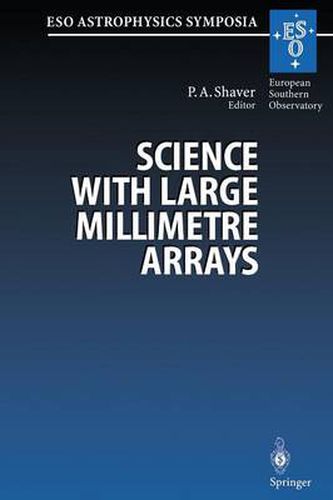Readings Newsletter
Become a Readings Member to make your shopping experience even easier.
Sign in or sign up for free!
You’re not far away from qualifying for FREE standard shipping within Australia
You’ve qualified for FREE standard shipping within Australia
The cart is loading…






This title is printed to order. This book may have been self-published. If so, we cannot guarantee the quality of the content. In the main most books will have gone through the editing process however some may not. We therefore suggest that you be aware of this before ordering this book. If in doubt check either the author or publisher’s details as we are unable to accept any returns unless they are faulty. Please contact us if you have any questions.
The next major step in millimetre astronomy, and one of the highest-priority items in radio astronomy today, is a large millimetre array with a collecting area 2 of up to 10 000 m . A project of this scale will almost certainly require inter national collaboration, at least within Europe, and possibly with other major partners elsewhere. In order to establish a focal point for this project within Europe, a study has been undertaken by the Institut de Radio Astronomie Mil Ii met rique (IRAM), the European Southern Observatory (ESO), The Onsala Space Observatory (OSO), and The Netherlands Foundation for Research in Astronomy (NFRA). In the context of this project, a workshop attended by some 100 participants was held at ESO Garching on December 11-13, 1995 to discuss the scientific advances such an array will make possible. Throughout the three days of the workshop the strong enthusiasm for the concept of a large millimetre array in the southern hemisphere (the Large South ern Array, or LSA) was obvious, and it became clear that such a facility would have a profound impact on almost all areas of observational astrophysics. It was particularly clear that, since their main science drivers (cosmology, and the origins of galaxies, stars and planets) are the same, and their angular resolutions and sensitivities similar, the LSA and the VLT would strongly complement each other.
$9.00 standard shipping within Australia
FREE standard shipping within Australia for orders over $100.00
Express & International shipping calculated at checkout
This title is printed to order. This book may have been self-published. If so, we cannot guarantee the quality of the content. In the main most books will have gone through the editing process however some may not. We therefore suggest that you be aware of this before ordering this book. If in doubt check either the author or publisher’s details as we are unable to accept any returns unless they are faulty. Please contact us if you have any questions.
The next major step in millimetre astronomy, and one of the highest-priority items in radio astronomy today, is a large millimetre array with a collecting area 2 of up to 10 000 m . A project of this scale will almost certainly require inter national collaboration, at least within Europe, and possibly with other major partners elsewhere. In order to establish a focal point for this project within Europe, a study has been undertaken by the Institut de Radio Astronomie Mil Ii met rique (IRAM), the European Southern Observatory (ESO), The Onsala Space Observatory (OSO), and The Netherlands Foundation for Research in Astronomy (NFRA). In the context of this project, a workshop attended by some 100 participants was held at ESO Garching on December 11-13, 1995 to discuss the scientific advances such an array will make possible. Throughout the three days of the workshop the strong enthusiasm for the concept of a large millimetre array in the southern hemisphere (the Large South ern Array, or LSA) was obvious, and it became clear that such a facility would have a profound impact on almost all areas of observational astrophysics. It was particularly clear that, since their main science drivers (cosmology, and the origins of galaxies, stars and planets) are the same, and their angular resolutions and sensitivities similar, the LSA and the VLT would strongly complement each other.